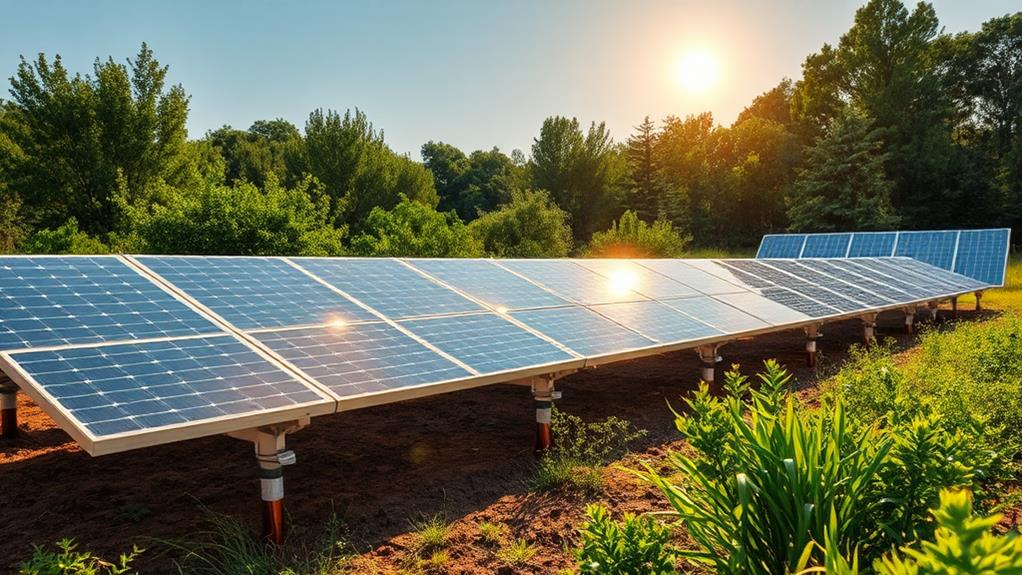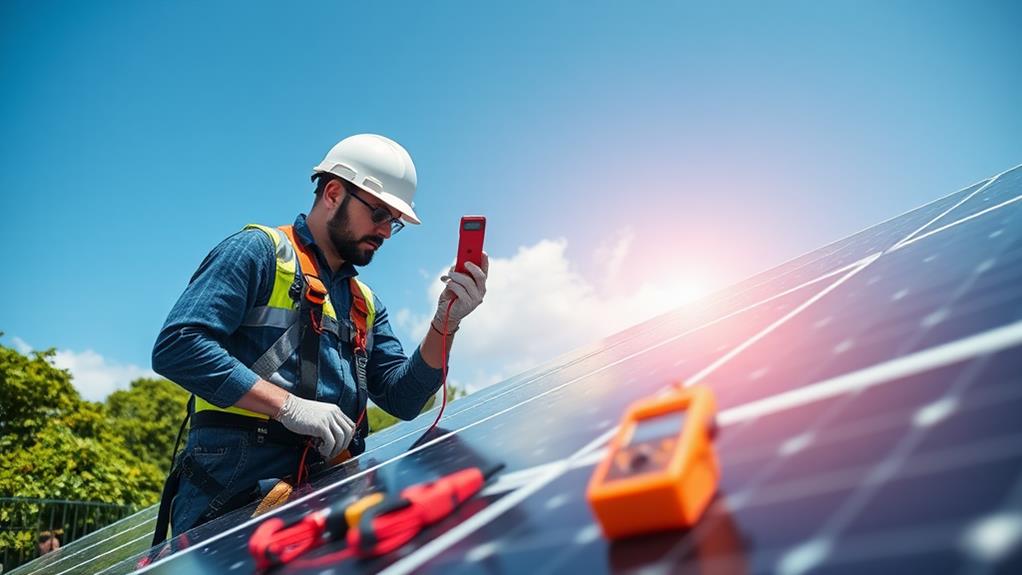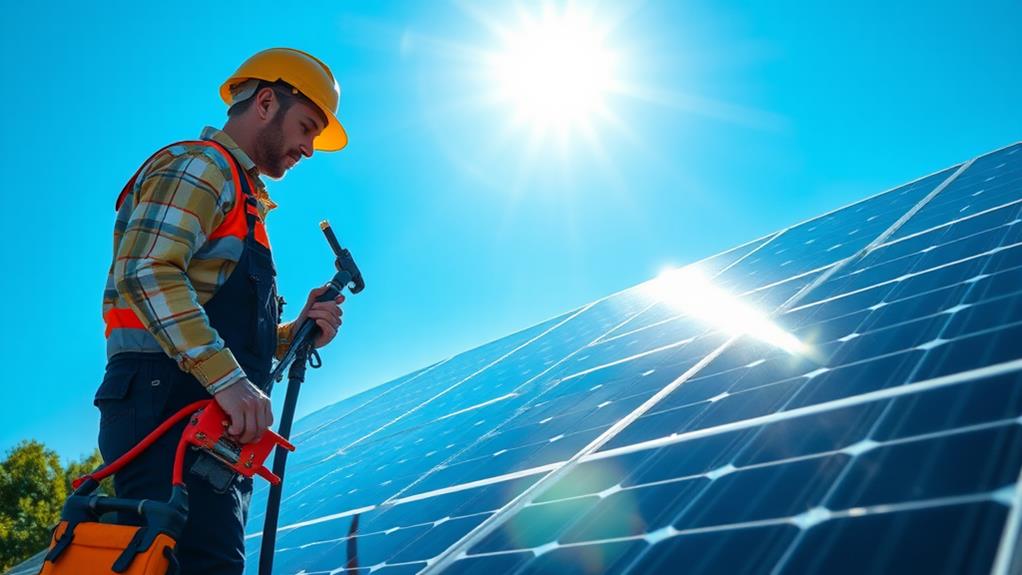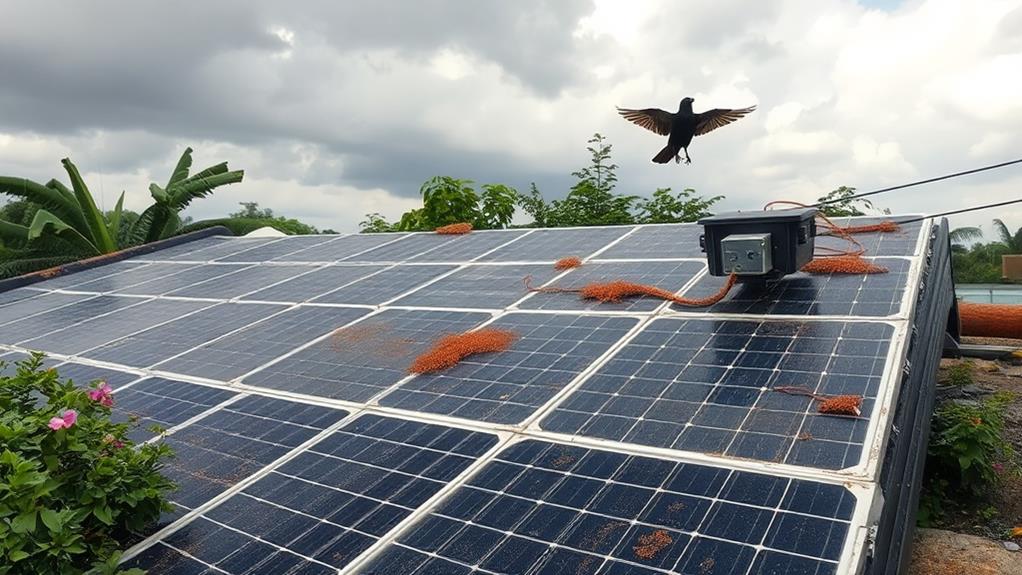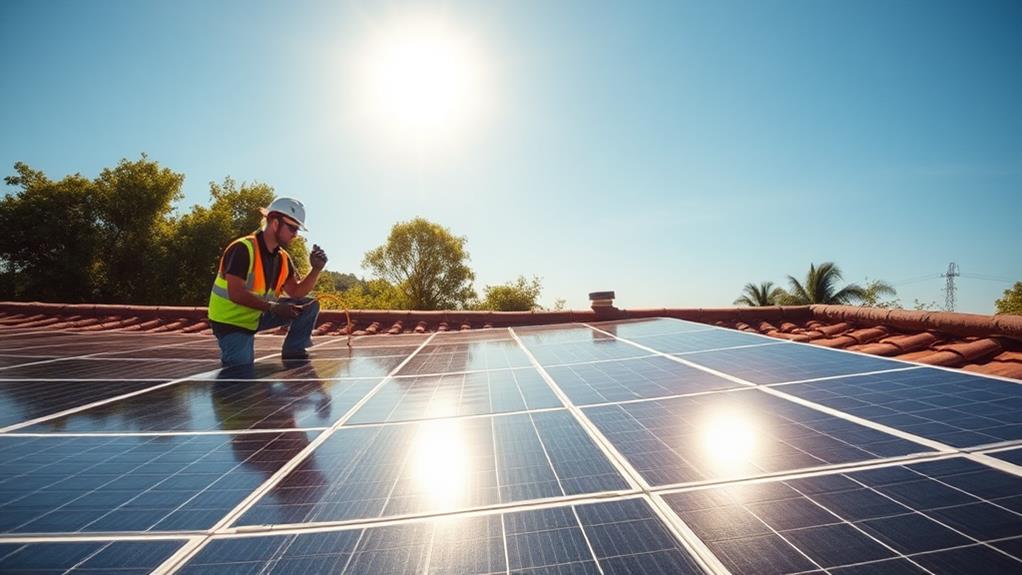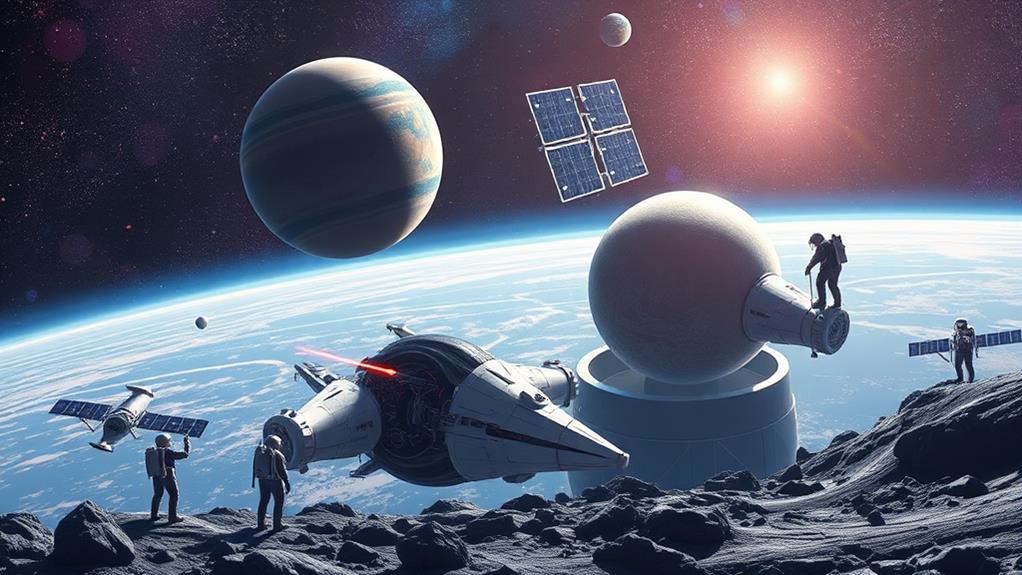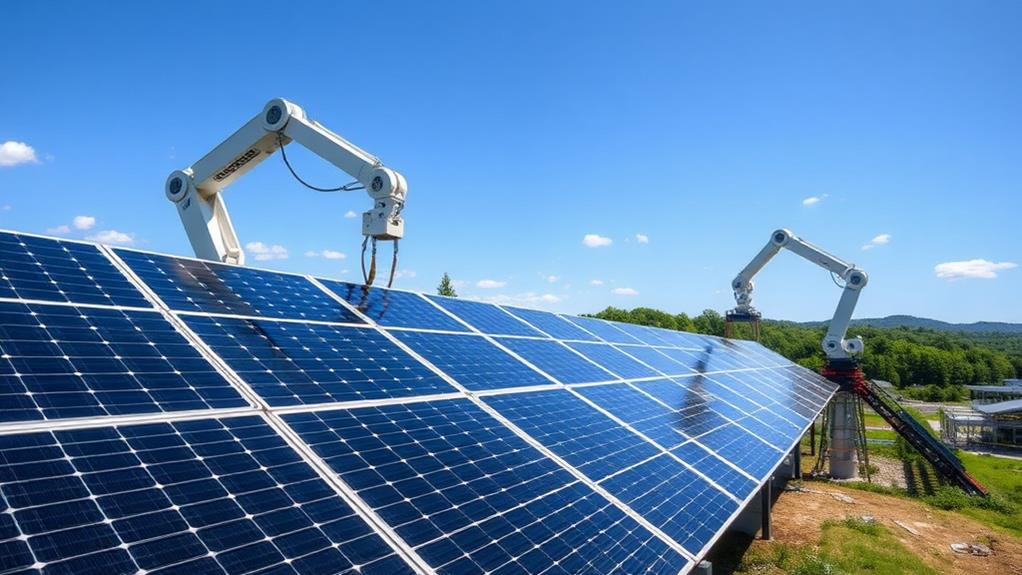Let's examine the crucial aspects of solar earthing and grounding, which are key to the safety and efficiency of solar installations. By linking photovoltaic panels and inverters to the Earth, we prevent electrical hazards like shocks and fires. Proper grounding not only safeguards equipment and personnel but also guarantees compliance with essential safety codes and regulations. It improves system reliability, decreases fire risks, and enhances operational efficiency. As we address obstacles from traditional methods, we observe how advancements like specialized washers and stainless steel fasteners are evolving. Uncover how robust grounding practices ensure long-term safety and performance in solar systems.
Key Takeaways
- Solar grounding connects PV panels and inverters to Earth to prevent electrical hazards.
- Proper grounding reduces risks of electrical shocks and fires in installations.
- Compliance with local electrical codes is crucial for system safety and performance.
- Grounding enhances solar system reliability, efficiency, and longevity.
- Innovations in grounding technology address traditional challenges and improve installation efficiency.
Understanding Solar Grounding
In solar installations, understanding the significance of solar grounding is essential for safety and efficiency. It's vital to prioritise grounding in our solar systems due to its role in connecting photovoltaic (PV) panels and inverters to the Earth, which prevents electrical hazards. Grounding provides a secure discharge path, reducing the risk of shocks and fires and supporting our collective goal of clean energy.
Implementing proper safety measures ensures that our solar installations comply with necessary electrical codes and standards. Compliance not only protects our homes but also unites us under shared standards, fostering a sense of community responsibility. Effective solar grounding enhances the reliability and longevity of our systems, allowing us to confidently contribute to a sustainable future.
Understanding solar grounding means adopting a commitment to collective safety and system protection. Collaborating to ensure our solar installations are properly grounded strengthens our dedication to safety and reliability in sustainable energy pursuits.
For instance, consider using the Schneider Electric Easy9 range of circuit breakers, available in South Africa, known for their robustness and compliance with electrical standards. These products are designed to integrate seamlessly with solar systems, ensuring optimal grounding and system protection.
Benefits of Proper Earthing
When we focus on proper earthing in our solar installations, we prioritize system safety by protecting both equipment and personnel from electrical hazards. This practice not only prevents potential shocks and downtime but also extends the longevity of the equipment, ensuring our systems run smoothly and efficiently.
Ensuring System Safety
Proper grounding is vital for the safety and reliability of solar power systems. Implementing effective safety measures and grounding practices protects both equipment and individuals from electrical surges and shocks. These steps are essential for reducing accidents, particularly during maintenance activities. A commitment to creating a safe environment aligns with grounding, fostering a secure and stable system.
Strong grounding practices improve system stability and efficiency while ensuring compliance with electrical codes and standards. Such adherence is crucial for maintaining safe operation of solar installations. Prioritising these measures reduces the likelihood of fire hazards from electrical faults, enhancing overall system safety.
Investing in solar technology with thorough grounding measures is key for long-term reliability. As a community focused on sustainable energy, safeguarding our investment and ensuring its longevity is significant. Ensuring that solar systems are well-grounded and safe prepares them for the future. Consider using products like the Victron Energy Lynx Distributor for effective grounding solutions.
Preventing Electrical Hazards
Utilising proper earthing in solar installations enhances safety and protects investments from electrical hazards. Effective grounding techniques provide a secure pathway for dissipating electrical faults, ensuring solar panels and inverters are safeguarded against unexpected surges. This practice aligns with community standards prioritising safety and efficiency.
Implementing robust earthing ensures compliance with electrical codes and standards, boosting the stability and efficiency of systems. It's reassuring to be part of a collective effort to maintain these safety measures. This approach protects both equipment and the individuals responsible for maintenance. Proper earthing significantly reduces the risk of electrical shocks, enhancing the safety of personnel.
Moreover, maintaining these grounding techniques minimises fire hazards associated with electrical faults. This commitment prevents damage and fosters a sense of responsibility towards others in the solar community. Prioritising hazard prevention helps build a safer, more connected environment.
For effective grounding, consider using products like the Schneider Electric Easy9 Earthing Bar, available for approximately 150 ZAR. This reliable choice ensures a solid foundation for safety and efficiency in solar installations.
Enhancing Equipment Longevity**
Our commitment to preventing electrical hazards naturally encourages us to consider the benefits of proper earthing in enhancing equipment longevity. Implementing effective grounding techniques significantly reduces the risk of equipment damage, allowing solar panels and inverters to operate safely and efficiently. Proper earthing dissipates electrical faults safely, safeguarding equipment from surges that could otherwise lead to damage or failures.
To be part of a community that values sustainability and innovation, adopting strong maintenance practices is essential. Secure earthing maintains stability and efficiency in solar systems and guarantees compliance with electrical codes and standards. Compliance minimises the likelihood of system failures, keeping investments protected and operational for the long term.
Embracing grounding techniques lowers the risk of fire hazards associated with electrical faults in solar installations, improving safety and extending equipment lifespan. Utilising products like the DEHN Earthing Electrode can ensure optimal performance. As we commit to these practices, we strengthen our dedication to creating a safer, more sustainable world.
Compliance With Local Standards
As we investigate compliance with local standards, let's focus on grasping the regulatory requirements that govern solar earthing and grounding systems. Regular inspections and maintenance protocols are key to maintaining compliance and ensuring the safety and efficiency of our installations. By adhering to these safety standards, we minimize legal risks and improve the reliability of our solar systems.
Regulatory Requirements Overview
Ensuring compliance with local standards in solar earthing and grounding is crucial for the safety and effectiveness of solar installations. Regulatory adherence serves as protection against potential legal implications and guarantees our solar systems function safely and efficiently.
For instance, in the UK, the IET Wiring Regulations (BS 7671) provide specific guidelines to maintain the integrity of earthing systems. These local codes are requirements designed to protect us and the communities we serve.
Adhering to these standards helps avoid legal issues and potential penalties. It also fosters a sense of belonging within the broader industry. Aligning our practices with established regulations signals our dedication to safety and quality.
We're part of a community that values reliable and secure solar installations. This shared commitment to regulatory requirements ensures that we aren't just meeting the minimum expectations but exceeding them. Our collective efforts improve the safety and reliability of solar installations, creating trust and confidence in the systems we build together.
Inspection and Maintenance Protocols
Regular inspections and maintenance protocols are vital to ensure our solar earthing systems comply with local standards and operate safely. Structured inspection procedures help maintain compliance and preserve the integrity of our installations over time. Commitment to comprehensive inspections not only ensures adherence to local regulations but also enhances the performance of our solar grounding systems. It's a collective responsibility to conduct these checks routinely, providing peace of mind that our systems remain in peak condition.
Our maintenance guidelines focus on preserving the safety and reliability of our solar earthing setups. These include periodic inspections, prompt resolution of identified issues, and thorough documentation of inspection results. Documentation is essential for tracking maintenance activities and demonstrating compliance with regulatory requirements. It serves as a roadmap for maintaining the health of our systems, ensuring their longevity.
To excel in inspection and maintenance efforts, we invest in training programmes for our maintenance personnel. Providing them with the necessary skills ensures effective implementation of these protocols, fostering a sense of unity and shared purpose within our community.
Safety Standards Compliance
Our dedication to thorough inspections ensures compliance with local safety standards, essential for proper solar earthing and grounding practices. Adhering to regional safety regulations prevents potential electrical hazards and maintains the integrity of our solar systems. It's crucial to follow industry-specific guidelines to ensure our installations are safe and reliable.
Failing to meet these standards may result in serious legal consequences, including penalties for non-compliance. Staying informed about the latest regional codes and regulations is vital. This knowledge helps protect our investments and our community's well-being.
Regular inspections and meticulous documentation demonstrate our compliance with safety standards. They showcase our commitment to high-quality installations and reinforce our standing as responsible members of the solar industry. Collective adherence fosters a sense of belonging in a community that values safety and sustainability. Upholding these standards ensures our solar earthing systems remain dependable and secure for all who rely on them.
Challenges in Traditional Methods
In the realm of solar installations, individuals encounter substantial challenges with traditional grounding methods. A primary concern arises from the insulation issues associated with aluminium frames. These frames demand meticulous attention to preserve low-resistance electrical connections. The anodised surfaces of solar modules complicate matters further, as they can obstruct reliable electrical connections essential for grounding. Navigating these materials requires precision to ensure both safety and efficiency.
Historically, aluminium wiring has posed numerous difficulties. In the 1970s, instances of fires linked to aluminium wiring led to a reevaluation of grounding practices in solar systems. Today, heavy gauge copper wire is the norm for electrical connections, yet it presents challenges related to weight and flexibility.
To address these issues, stainless steel fasteners are frequently utilised. Such fasteners ensure proper bonding with copper wire, providing a dependable solution to the grounding dilemma. Understanding these challenges aids in constructing safer and more efficient solar installations, nurturing a community of knowledgeable and proactive solar enthusiasts.
Innovations in Grounding Technology
In the rapidly evolving world of solar technology, advancements in grounding are setting new benchmarks. A standout development is WEEB technology, enhancing performance and simplifying installations significantly. It directly grounds photovoltaic panels to aluminium rails using specialised washers, negating the need for separate ground wires. This streamlines installations and fosters a sense of community among solar professionals as we collectively embrace these innovations.
The secret lies in the washer's design, which features sharp ridges that penetrate coatings to establish reliable electrical connections. These gas-tight connections resist oxidation, ensuring long-term system performance. It's remarkable how WEEB products save time while ensuring compliance with safety standards.
As these technologies become widely adopted, they effectively address complex grounding challenges, allowing for a more integrated and efficient approach across the industry.
WEEB technology represents more than just a solution; it embodies our collective progress and commitment to improving solar installations. Let's continue embracing these innovations, knowing we're part of a pioneering community enhancing the future of solar energy.
Ensuring Safety and Reliability
Safety and reliability are crucial in any successful solar installation. In our community focused on sustainable energy, proper solar earthing and grounding practices are imperative. The aim is to protect both those maintaining these installations and the equipment. Effective grounding techniques are essential; they help dissipate electrical faults, prevent shocks, and significantly reduce fire hazards, enhancing system reliability and offering peace of mind for all involved.
Implementing thorough safety measures is necessary. Adherence to electrical codes and standards is a legal requirement and a commitment to each other and the planet. Strong earthing systems are required in solar installations to guard against electrical surges, maintain system stability, and support efficient operation. These systems prevent fire hazards associated with electrical faults, ensuring long-term integrity.
For optimal safety, consider using the Earthing Compound available for approximately ZAR 250, which enhances conductivity and reduces resistance.
Additionally, the Surge Protection Device, costing around ZAR 500, is recommended to safeguard against electrical surges.
Conclusion
As we conclude our discussion, we have explored the basics of solar grounding and the benefits of proper earthing. By adhering to local standards, we ensure the safety and efficiency of our solar installations. Although traditional methods come with challenges, advances in grounding technology offer promising solutions. We encourage you to stay informed about these advancements to enhance the reliability and safety of your solar systems.
If you have any questions or require further information, please feel free to contact Deo Solar. We specialise in a range of products including Rail-Less Solar Brackets, End Spacers, Structural Brackets, Ground Mounted Solar Systems, Corrugated Brackets, and Earthing Plates. Our services include the DeoSizer Tool, Evaluation and Design, Maintenance and Support, and Solar Installations. We are here to assist you, ensuring you harness the sun's energy effectively and responsibly.

